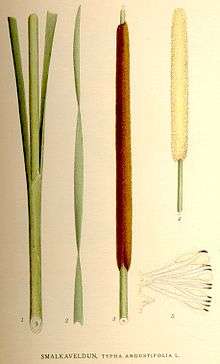Typha angustifolia
| Narrowleaf cattail | |
|---|---|
 | |
| Typha angustifolia | |
| Scientific classification | |
| Kingdom: | Plantae |
| Clade: | Angiosperms |
| Clade: | Monocots |
| Clade: | Commelinids |
| Order: | Poales |
| Family: | Typhaceae |
| Genus: | Typha |
| Species: | T. angustifolia |
| Binomial name | |
| Typha angustifolia L. | |
| Synonyms[1][2] | |
|
Synonyms list
| |
Typha angustifolia L. (also lesser bulrush,[3] narrowleaf cattail[4] or lesser reedmace) is a perennial herbaceous plant of genus Typha. This cattail is an "obligate wetland" species that is commonly found in the northern hemisphere in brackish locations.[5] The plant's leaves are flat, very narrow (¼"-½" wide), and 3'-6' tall when mature; 12-16 leaves arise from each vegetative shoot. At maturity, they have distinctive stalks that are about as tall as the leaves; the stalks are topped with brown, fluffy, sausage-shaped flowering heads. The plants have sturdy, rhizomatous roots that can extend 27" and are typically ¾"-1½" in diameter.[6][7]
It has been proposed that the species was introduced from Europe to North America.[8] In North America, it is also thought to have been introduced from coastal to inland locations.[9]
_1.jpg)
The geographic range of Typha angustifolia overlaps with the very similar species Typha latifolia (broadleaf or common cattail). T. angustifolia can be distinguished from T. latifolia by its narrower leaves and by a clear separation of two different regions (staminate flowers above and pistilate flowers below) on the flowering heads.[6] The species hybridize as Typha x glauca (Typha angustifolia x T. latifolia) (white cattail); Typha x glauca is not a distinct species, but is rather a sterile F1 hybrid.[10] Broadleaf cattail is usually found in shallower water than narrowleaf cattail.
Culinary use
Several parts of the plant are edible, including during various seasons the dormant sprouts on roots and bases of leaves, the inner core of the stalk, green bloom spikes, ripe pollen, and starchy roots.[11][12] The edible stem is called bồn bồn in Vietnam.photo
References
- ↑ Tropicos Typha angustifolia
- ↑ The Plant List Typha angustifolia
- ↑ "BSBI List 2007". Botanical Society of Britain and Ireland. Archived from the original (xls) on 2015-02-25. Retrieved 2014-10-17.
- ↑ "Typha angustifolia". Natural Resources Conservation Service PLANTS Database. USDA. Retrieved 12 December 2015.
- ↑ "Typha angustifolia - narrow leaf cattail". Global Biodiversity Information Facility. Retrieved 2011-03-16.
- 1 2 Rook, Earl J. S. (February 26, 2004). "Typha angustifolia: Narrow Leaf Cattail". Retrieved 2008-09-13.
- ↑ "PLANTS Profile for Typha angustifolia (narrowleaf cattail)". U. S. Department of Agriculture. Retrieved 2008-09-13.
- ↑ Stuckey, R. L.; Salamon, D. P. (1987). "Typha angustifolia in North America: masquerading as a native". Am. J. Bot. 74: 757.
- ↑ Mills, Edward L.; Leach, Joseph H.; Carlton, James T.; Secor, Carol L. (1993). "Exotic Species in the Great Lakes: A History of Biotic Crises and Anthropogenic Introductions" (PDF). Journal of Great Lakes Research. 19 (1): 1–54. doi:10.1016/S0380-1330(93)71197-1. Retrieved 2013-10-21.
The distributional history of the narrow-leaved cattail, a brackish water species native to the Atlantic coast, is debatable. The plant is thought to have invaded inland slowly with the early canal, railroad, and highway systems. It began a rapid inland expansion in through Central New York in the first half of the 20th Century when the de-icing of highways using salt became more widespread.
The link is to a preprint of the published article; see p. 46. - ↑ Selbo, Sarena M.; Snow, Allison A. (2004). "The potential for hybridization between Typha angustifolia and Typha latifolia in a constructed wetland" (PDF). Aquatic Botany. 78 (4): 361–369. doi:10.1016/j.aquabot.2004.01.003. Retrieved 2013-10-21.
- ↑ Elias, Thomas S.; Dykeman, Peter A. (2009) [1982]. Edible Wild Plants. New York, NY: Sterling Publishing Co., Inc. pp. 69–70. ISBN 978-1-4027-6715-9.
- ↑ "Typha angustifolia - Small reed mace". Plants for a Future. Retrieved 2011-03-16. External link in
|publisher=(help)
External links
- Typha angustifolia Photos, drawings, description from Nature Manitoba
| Wikimedia Commons has media related to Typha angustifolia. |